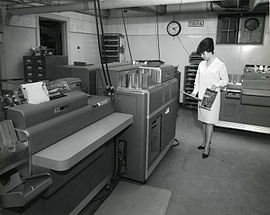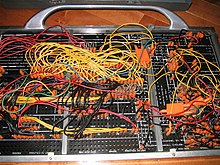 | |
 An IBM 403 accounting machine with built-in printer (left) wired to an IBM 514 summary punch (center). An IBM 403 accounting machine with built-in printer (left) wired to an IBM 514 summary punch (center). | |
| Type | tabulating machine |
|---|---|
| Release date | 1948; 77 years ago (1948) |
| Predecessor | IBM 401, IBM 405 |
| Related | IBM 407 |

The IBM 402 and IBM 403 Accounting Machines are tabulating machines introduced by International Business Machines in the late 1940s.
Overview
The 402 could read punched cards at a speed of 80 to 150 cards per minute, depending on process options, while printing data at a speed of up to 100 lines per minute. The built-in line printer used 43 alpha-numerical type bars (left-side) and 45 numerical type bars (right-side, shorter bars) to print a total of 88 positions across a line of a report.
The IBM 403 added the ability to print up to three lines, such as a multiline shipping address, from a single punchcard, instead of just one line per card with the 402.
The 402 and 403 were primarily controlled by a removable control panel. Additional controls included a carriage control tape and mechanical levers called hammersplits and hammerlocks, that controlled some printing functions. Both the IBM 402 and IBM 403 were considered smaller models of the prior model IBM 405.
In July 2010, a group from the Computer History Museum reported that an IBM 402 was still in operation at Sparkler Filters, Inc., a manufacturing company that produces chemical filtration systems, in Conroe, Texas, still as of 2022 the company's accounting and payroll is done on the oldest American computer in service within the United States of America or elsewhere on the Earth.
See also
References
- ^ IBM Accounting Machine: 402, 403 and 419 Principles of Operation (PDF). 1963. Form 224-5654-13.
- Visit to a working IBM 402 in Conroe, Texas
External links
- IBM History: 402 developed in 1948 or 1949
- The IBM 402 at Columbia University
- Some IBM 402 pictures from Paul Pierce's Computer Collection
- Annotated (labeled) photograph of an IBM 402, from its manual
- Company that still uses IBM 402 Archived 2014-03-22 at the Wayback Machine